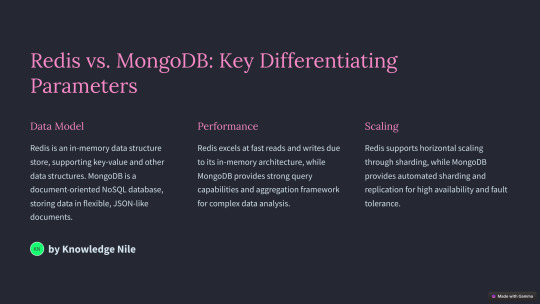#Data Model
Explore tagged Tumblr posts
Text
Bought a database design book older than me. Let's find out how the best practices have evolved since the 90s...

#data modeling#data model#vintage IT books#the language is very “CS Degree dense”#but the author near immediately made a not very covert dig at people who reuse free text fields for random other data#so he has my attention and support#(dys)functional analysis
3 notes
·
View notes
Text

Redis vs. MongoDB: Which Database is Right for You?
Choosing between Redis and MongoDB for your project? Redis offers blazing-fast caching and real-time data processing, while MongoDB excels in handling large-scale, flexible document-based storage. Dive into the pros, cons, and use cases of both databases to find the perfect fit for your needs. Click the link to explore the full comparison and unlock your next big project’s potential!
0 notes
Text
Enhancing Digital Marketing Processes with Data Analytics

Data analytics, in marketing, is the process of collecting and analysing data from a range of sources to gain actionable insights into a business’s digital marketing processes and strategies. Analytics tools can be used to minimise churn rate, identify potential new approaches and create a personalised customer experience.
What Are the Different Types of Data to Analyse?
A business’s digital marketing strategy will determine the type of data that will be utilised. This could include web analytics or social media data, or data derived from lead generation or blog and content creation processes. Understanding and analysing this data will help dictate the ROI (return on investment) expected to be generated from the marketing strategy, as well as the elements of the strategy that are working well and what requires tweaking.
Choosing an Analytical Data Model
Experienced marketers like serial entrepreneur Volker Hartzsch understand that in order to best plan, manage and optimise their marketing campaigns, businesses can select from three types of analytical models. The first of these is descriptive, which uses historical data from previous campaigns, and the second is predictive, which uses insights from former marketing campaigns to predict customer behaviour. The third model is prescriptive, which involves collecting data from all touchpoints to assess the impact of each customer interaction and company initiative to create a highly targeted marketing campaign.
The Benefits of Using Data Analytics
Data can be used by digital marketers to help them understand a business’s target market, allowing them to market the business’s services or products to the best possible effect. Another benefit of using data is that it allows businesses to budget more effectively, identify new opportunities and uplift the general customer experience. In terms of the latter, this could be through the ability to provide content that specifically caters to a specific market segment, thereby helping to increase both engagement and conversion levels.
Data also allows businesses to build brand awareness and access customers in real time by triggering campaigns to launch at a time when potential customers are active and most likely to engage.
Getting Started with Using Data
Businesses wishing to get started with using data in their digital marketing strategies should first determine their goals and identify their KPIs (key performance indicators). Following this, customer personas should be generated to help prioritise the target audience’s wants and needs. Finally, all data should be evaluated to measure the success of each campaign.
1 note
·
View note
Text
Understanding the Basics of Team Foundation Server (TFS)

In software engineering, a streamlined system for project management is vital. Team Foundation Server (TFS) provides a full suite of tools for the entire software development lifecycle.
TFS is now part of Azure DevOps Services. It is a Microsoft tool supporting the entire software development lifecycle. It centralizes collaboration, version control, build automation, testing, and release management. TFS (Talend Open Studio) is the foundation for efficient teamwork and the delivery of top-notch software.
Key Components of TFS
The key components of team foundation server include-
Azure DevOps Services (formerly TFS): It is the cloud-based version of TFS. It offers a set of integrated tools and services for DevOps practices.
Version Control: TFS provides version control features for managing source code. It includes centralized version control and distributed version control.
Work Item Tracking: It allows teams to track and manage tasks, requirements, bugs, and other development-related activities.
Build Automation: TFS enables the automation of the build process. It allows developers to create and manage build definitions to compile and deploy applications.
Test Management: TFS includes test management tools for planning, tracking, and managing testing efforts. It supports manual and automated testing processes.
Release Management: Release Management automates the deployment of applications across various environments. It ensures consistency and reliability in the release process.
Reporting and Analytics: TFS provides reporting tools that allow teams to analyze their development processes. Custom reports and dashboards can be created to gain insights into project progress.
Authentication and Authorization: TFS and Azure DevOps manage user access, permissions, and security settings. It helps to protect source code and project data.
Package Management: Azure DevOps features a package management system for teams to handle and distribute software packages and dependencies.
Code Search: Azure DevOps provides powerful code search capabilities to help developers find and explore code efficiently.
Importance of TFS
Here are some aspects of TFS that highlight its importance-
Collaboration and Communication: It centralizes collaboration by integrating work items, version control, and building processes for seamless teamwork.
Data-Driven Decision Making: It provides reporting and analytics tools. It allows teams to generate custom reports and dashboards. These insights empower data-driven decision-making. It helps the team evaluate progress and identify areas for improvement.
Customization and Extensibility: It allows customization to adapt to specific team workflows. Its rich set of APIs enables integration with third-party tools. It enhances flexibility and extensibility based on team needs.
Auditing and Compliance: It provides auditing capabilities. It helps organizations track changes and ensure compliance with industry regulations and standards.
Team Foundation Server plays a pivotal role in modern software development. It provides an integrated and efficient platform for collaboration, automation, and project management.
Learn more about us at Nitor Infotech.
#Team Foundation Server#data engineering#sql server#big data#data warehousing#data model#microsoft sql server#sql code#data integration#integration of data#big data analytics#nitor infotech#software services
1 note
·
View note
Text

Can confirm the power of celebrity endorsement is real 😳😳 I somehow managed to sell this fictional cologne to myself while drawing them
#honkai star rail#hsr fanart#aventio#ratiorine#golden ratio#hsr aventurine#hsr ratio#dr ratio#star rail fanart#hsr#digital art#artists on tumblr#husband worm’s art#I’m NOT going to call them Raturine but my gf thinks it’s funny 💀#Aventurine is here as a fabulous model slaying and ratio is here for the cologne scent data collection
4K notes
·
View notes
Text
Who Needs A Data Model Anyway?
These days, there is much conversation about the necessity of the data model. The data model has been around for several decades now and can be classified as an artifact of an earlier day and age. But is the data model really out of date read more
0 notes
Note
I have never been more concerned for a JP update from your art than I am seeing a Cheka knowing the context of Leona’s dream.
My bois ok right?????? My sweet nephews ok right??????
well
uhhhh
I'm sure the real one is fine :)
#twisted wonderland#twisted wonderland spoilers#twisted wonderland episode 7 spoilers#twisted wonderland book 7 spoilers#twisted wonderland episode 7 part 11 spoilers#twisted wonderland book 7 part 11 spoilers#unfortunately leona's ultimate happy dream did involve his entire family dying tragically. them's the breaks.#(for the record he is a little messed up about this) (he is a little messed up about a lot of stuff)#the context of cheka is that they were going to try to shock leona awake by having him show up#however while styx could provide them with a 3d model based on a bodyscan (which they had for...reasons??) they had no data on his behavior#so he was basically just a little frozen mannequin#(the sprite was not t-posing but in my heart this was happening)#ruggie could kind of pilot him with his magic but it only lasts for a few seconds so he had to keep recasting it with noticeable choppiness#so while we don't get the entire effect due to the limitations of the format#this means that leona was in the middle of let-them-eat-cake'ing a revolution when suddenly#his late nephew bursts jerkily in through the door yelling OJITAN I'M ALIVE AND MY VOICE CHANGED OFFSCREEN#honestly they spent more time thinking of how to explain ruggie's terrible impression of cheka than anything else#how could leona have seen through this brilliant plan so quickly 🤔#man i really did love his horrible dream though#i like him as a character but i wasn't expecting his dream to be the one that got to me like that#love how all the savana dreams were like#jack: what if leona was really cool and my friend :)#ruggie: what if my dad came back and leona created a socialist utopia for me :)#leona: what if i finally got the chance to prove myself except i screwed everything up and everyone hated me and my family was dead#his conversation with kifaji at the end 😭#kifaji in his dream in GENERAL acting as a counterpoint to his phantom like. like!!!! (waves hands)#i just. these guys.#me 4+ years ago: this game looks so dumb i gotta try it. surely i won't become emotionally overinvested in any of this.
377 notes
·
View notes
Text
Your car spies on you and rats you out to insurance companies

I'm on tour with my new, nationally bestselling novel The Bezzle! Catch me TOMORROW (Mar 13) in SAN FRANCISCO with ROBIN SLOAN, then Toronto, NYC, Anaheim, and more!

Another characteristically brilliant Kashmir Hill story for The New York Times reveals another characteristically terrible fact about modern life: your car secretly records fine-grained telemetry about your driving and sells it to data-brokers, who sell it to insurers, who use it as a pretext to gouge you on premiums:
https://www.nytimes.com/2024/03/11/technology/carmakers-driver-tracking-insurance.html
Almost every car manufacturer does this: Hyundai, Nissan, Ford, Chrysler, etc etc:
https://www.repairerdrivennews.com/2020/09/09/ford-state-farm-ford-metromile-honda-verisk-among-insurer-oem-telematics-connections/
This is true whether you own or lease the car, and it's separate from the "black box" your insurer might have offered to you in exchange for a discount on your premiums. In other words, even if you say no to the insurer's carrot – a surveillance-based discount – they've got a stick in reserve: buying your nonconsensually harvested data on the open market.
I've always hated that saying, "If you're not paying for the product, you're the product," the reason being that it posits decent treatment as a customer reward program, like the little ramekin warm nuts first class passengers get before takeoff. Companies don't treat you well when you pay them. Companies treat you well when they fear the consequences of treating you badly.
Take Apple. The company offers Ios users a one-tap opt-out from commercial surveillance, and more than 96% of users opted out. Presumably, the other 4% were either confused or on Facebook's payroll. Apple – and its army of cultists – insist that this proves that our world's woes can be traced to cheapskate "consumers" who expected to get something for nothing by using advertising-supported products.
But here's the kicker: right after Apple blocked all its rivals from spying on its customers, it began secretly spying on those customers! Apple has a rival surveillance ad network, and even if you opt out of commercial surveillance on your Iphone, Apple still secretly spies on you and uses the data to target you for ads:
https://pluralistic.net/2022/11/14/luxury-surveillance/#liar-liar
Even if you're paying for the product, you're still the product – provided the company can get away with treating you as the product. Apple can absolutely get away with treating you as the product, because it lacks the historical constraints that prevented Apple – and other companies – from treating you as the product.
As I described in my McLuhan lecture on enshittification, tech firms can be constrained by four forces:
I. Competition
II. Regulation
III. Self-help
IV. Labor
https://pluralistic.net/2024/01/30/go-nuts-meine-kerle/#ich-bin-ein-bratapfel
When companies have real competitors – when a sector is composed of dozens or hundreds of roughly evenly matched firms – they have to worry that a maltreated customer might move to a rival. 40 years of antitrust neglect means that corporations were able to buy their way to dominance with predatory mergers and pricing, producing today's inbred, Habsburg capitalism. Apple and Google are a mobile duopoly, Google is a search monopoly, etc. It's not just tech! Every sector looks like this:
https://www.openmarketsinstitute.org/learn/monopoly-by-the-numbers
Eliminating competition doesn't just deprive customers of alternatives, it also empowers corporations. Liberated from "wasteful competition," companies in concentrated industries can extract massive profits. Think of how both Apple and Google have "competitively" arrived at the same 30% app tax on app sales and transactions, a rate that's more than 1,000% higher than the transaction fees extracted by the (bloated, price-gouging) credit-card sector:
https://pluralistic.net/2023/06/07/curatorial-vig/#app-tax
But cartels' power goes beyond the size of their warchest. The real source of a cartel's power is the ease with which a small number of companies can arrive at – and stick to – a common lobbying position. That's where "regulatory capture" comes in: the mobile duopoly has an easier time of capturing its regulators because two companies have an easy time agreeing on how to spend their app-tax billions:
https://pluralistic.net/2022/06/05/regulatory-capture/
Apple – and Google, and Facebook, and your car company – can violate your privacy because they aren't constrained regulation, just as Uber can violate its drivers' labor rights and Amazon can violate your consumer rights. The tech cartels have captured their regulators and convinced them that the law doesn't apply if it's being broken via an app:
https://pluralistic.net/2023/04/18/cursed-are-the-sausagemakers/#how-the-parties-get-to-yes
In other words, Apple can spy on you because it's allowed to spy on you. America's last consumer privacy law was passed in 1988, and it bans video-store clerks from leaking your VHS rental history. Congress has taken no action on consumer privacy since the Reagan years:
https://www.eff.org/tags/video-privacy-protection-act
But tech has some special enshittification-resistant characteristics. The most important of these is interoperability: the fact that computers are universal digital machines that can run any program. HP can design a printer that rejects third-party ink and charge $10,000/gallon for its own colored water, but someone else can write a program that lets you jailbreak your printer so that it accepts any ink cartridge:
https://www.eff.org/deeplinks/2020/11/ink-stained-wretches-battle-soul-digital-freedom-taking-place-inside-your-printer
Tech companies that contemplated enshittifying their products always had to watch over their shoulders for a rival that might offer a disenshittification tool and use that as a wedge between the company and its customers. If you make your website's ads 20% more obnoxious in anticipation of a 2% increase in gross margins, you have to consider the possibility that 40% of your users will google "how do I block ads?" Because the revenue from a user who blocks ads doesn't stay at 100% of the current levels – it drops to zero, forever (no user ever googles "how do I stop blocking ads?").
The majority of web users are running an ad-blocker:
https://doc.searls.com/2023/11/11/how-is-the-worlds-biggest-boycott-doing/
Web operators made them an offer ("free website in exchange for unlimited surveillance and unfettered intrusions") and they made a counteroffer ("how about 'nah'?"):
https://www.eff.org/deeplinks/2019/07/adblocking-how-about-nah
Here's the thing: reverse-engineering an app – or any other IP-encumbered technology – is a legal minefield. Just decompiling an app exposes you to felony prosecution: a five year sentence and a $500k fine for violating Section 1201 of the DMCA. But it's not just the DMCA – modern products are surrounded with high-tech tripwires that allow companies to invoke IP law to prevent competitors from augmenting, recongifuring or adapting their products. When a business says it has "IP," it means that it has arranged its legal affairs to allow it to invoke the power of the state to control its customers, critics and competitors:
https://locusmag.com/2020/09/cory-doctorow-ip/
An "app" is just a web-page skinned in enough IP to make it a crime to add an ad-blocker to it. This is what Jay Freeman calls "felony contempt of business model" and it's everywhere. When companies don't have to worry about users deploying self-help measures to disenshittify their products, they are freed from the constraint that prevents them indulging the impulse to shift value from their customers to themselves.
Apple owes its existence to interoperability – its ability to clone Microsoft Office's file formats for Pages, Numbers and Keynote, which saved the company in the early 2000s – and ever since, it has devoted its existence to making sure no one ever does to Apple what Apple did to Microsoft:
https://www.eff.org/deeplinks/2019/06/adversarial-interoperability-reviving-elegant-weapon-more-civilized-age-slay
Regulatory capture cuts both ways: it's not just about powerful corporations being free to flout the law, it's also about their ability to enlist the law to punish competitors that might constrain their plans for exploiting their workers, customers, suppliers or other stakeholders.
The final historical constraint on tech companies was their own workers. Tech has very low union-density, but that's in part because individual tech workers enjoyed so much bargaining power due to their scarcity. This is why their bosses pampered them with whimsical campuses filled with gourmet cafeterias, fancy gyms and free massages: it allowed tech companies to convince tech workers to work like government mules by flattering them that they were partners on a mission to bring the world to its digital future:
https://pluralistic.net/2023/09/10/the-proletarianization-of-tech-workers/
For tech bosses, this gambit worked well, but failed badly. On the one hand, they were able to get otherwise powerful workers to consent to being "extremely hardcore" by invoking Fobazi Ettarh's spirit of "vocational awe":
https://www.inthelibrarywiththeleadpipe.org/2018/vocational-awe/
On the other hand, when you motivate your workers by appealing to their sense of mission, the downside is that they feel a sense of mission. That means that when you demand that a tech worker enshittifies something they missed their mother's funeral to deliver, they will experience a profound sense of moral injury and refuse, and that worker's bargaining power means that they can make it stick.
Or at least, it did. In this era of mass tech layoffs, when Google can fire 12,000 workers after a $80b stock buyback that would have paid their wages for the next 27 years, tech workers are learning that the answer to "I won't do this and you can't make me" is "don't let the door hit you in the ass on the way out" (AKA "sharpen your blades boys"):
https://techcrunch.com/2022/09/29/elon-musk-texts-discovery-twitter/
With competition, regulation, self-help and labor cleared away, tech firms – and firms that have wrapped their products around the pluripotently malleable core of digital tech, including automotive makers – are no longer constrained from enshittifying their products.
And that's why your car manufacturer has chosen to spy on you and sell your private information to data-brokers and anyone else who wants it. Not because you didn't pay for the product, so you're the product. It's because they can get away with it.
Cars are enshittified. The dozens of chips that auto makers have shoveled into their car design are only incidentally related to delivering a better product. The primary use for those chips is autoenshittification – access to legal strictures ("IP") that allows them to block modifications and repairs that would interfere with the unfettered abuse of their own customers:
https://pluralistic.net/2023/07/24/rent-to-pwn/#kitt-is-a-demon
The fact that it's a felony to reverse-engineer and modify a car's software opens the floodgates to all kinds of shitty scams. Remember when Bay Staters were voting on a ballot measure to impose right-to-repair obligations on automakers in Massachusetts? The only reason they needed to have the law intervene to make right-to-repair viable is that Big Car has figured out that if it encrypts its diagnostic messages, it can felonize third-party diagnosis of a car, because decrypting the messages violates the DMCA:
https://www.eff.org/deeplinks/2013/11/drm-cars-will-drive-consumers-crazy
Big Car figured out that VIN locking – DRM for engine components and subassemblies – can felonize the production and the installation of third-party spare parts:
https://pluralistic.net/2022/05/08/about-those-kill-switched-ukrainian-tractors/
The fact that you can't legally modify your car means that automakers can go back to their pre-2008 ways, when they transformed themselves into unregulated banks that incidentally manufactured the cars they sold subprime loans for. Subprime auto loans – over $1t worth! – absolutely relies on the fact that borrowers' cars can be remotely controlled by lenders. Miss a payment and your car's stereo turns itself on and blares threatening messages at top volume, which you can't turn off. Break the lease agreement that says you won't drive your car over the county line and it will immobilize itself. Try to change any of this software and you'll commit a felony under Section 1201 of the DMCA:
https://pluralistic.net/2021/04/02/innovation-unlocks-markets/#digital-arm-breakers
Tesla, naturally, has the most advanced anti-features. Long before BMW tried to rent you your seat-heater and Mercedes tried to sell you a monthly subscription to your accelerator pedal, Teslas were demon-haunted nightmare cars. Miss a Tesla payment and the car will immobilize itself and lock you out until the repo man arrives, then it will blare its horn and back itself out of its parking spot. If you "buy" the right to fully charge your car's battery or use the features it came with, you don't own them – they're repossessed when your car changes hands, meaning you get less money on the used market because your car's next owner has to buy these features all over again:
https://pluralistic.net/2023/07/28/edison-not-tesla/#demon-haunted-world
And all this DRM allows your car maker to install spyware that you're not allowed to remove. They really tipped their hand on this when the R2R ballot measure was steaming towards an 80% victory, with wall-to-wall scare ads that revealed that your car collects so much information about you that allowing third parties to access it could lead to your murder (no, really!):
https://pluralistic.net/2020/09/03/rip-david-graeber/#rolling-surveillance-platforms
That's why your car spies on you. Because it can. Because the company that made it lacks constraint, be it market-based, legal, technological or its own workforce's ethics.
One common critique of my enshittification hypothesis is that this is "kind of sensible and normal" because "there’s something off in the consumer mindset that we’ve come to believe that the internet should provide us with amazing products, which bring us joy and happiness and we spend hours of the day on, and should ask nothing back in return":
https://freakonomics.com/podcast/how-to-have-great-conversations/
What this criticism misses is that this isn't the companies bargaining to shift some value from us to them. Enshittification happens when a company can seize all that value, without having to bargain, exploiting law and technology and market power over buyers and sellers to unilaterally alter the way the products and services we rely on work.
A company that doesn't have to fear competitors, regulators, jailbreaking or workers' refusal to enshittify its products doesn't have to bargain, it can take. It's the first lesson they teach you in the Darth Vader MBA: "I am altering the deal. Pray I don't alter it any further":
https://pluralistic.net/2023/10/26/hit-with-a-brick/#graceful-failure
Your car spying on you isn't down to your belief that your carmaker "should provide you with amazing products, which brings your joy and happiness you spend hours of the day on, and should ask nothing back in return." It's not because you didn't pay for the product, so now you're the product. It's because they can get away with it.
The consequences of this spying go much further than mere insurance premium hikes, too. Car telemetry sits at the top of the funnel that the unbelievably sleazy data broker industry uses to collect and sell our data. These are the same companies that sell the fact that you visited an abortion clinic to marketers, bounty hunters, advertisers, or vengeful family members pretending to be one of those:
https://pluralistic.net/2022/05/07/safegraph-spies-and-lies/#theres-no-i-in-uterus
Decades of pro-monopoly policy led to widespread regulatory capture. Corporate cartels use the monopoly profits they extract from us to pay for regulatory inaction, allowing them to extract more profits.
But when it comes to privacy, that period of unchecked corporate power might be coming to an end. The lack of privacy regulation is at the root of so many problems that a pro-privacy movement has an unstoppable constituency working in its favor.
At EFF, we call this "privacy first." Whether you're worried about grifters targeting vulnerable people with conspiracy theories, or teens being targeted with media that harms their mental health, or Americans being spied on by foreign governments, or cops using commercial surveillance data to round up protesters, or your car selling your data to insurance companies, passing that long-overdue privacy legislation would turn off the taps for the data powering all these harms:
https://www.eff.org/wp/privacy-first-better-way-address-online-harms
Traditional economics fails because it thinks about markets without thinking about power. Monopolies lead to more than market power: they produce regulatory capture, power over workers, and state capture, which felonizes competition through IP law. The story that our problems stem from the fact that we just don't spend enough money, or buy the wrong products, only makes sense if you willfully ignore the power that corporations exert over our lives. It's nice to think that you can shop your way out of a monopoly, because that's a lot easier than voting your way out of a monopoly, but no matter how many times you vote with your wallet, the cartels that control the market will always win:
https://pluralistic.net/2024/03/05/the-map-is-not-the-territory/#apor-locksmith

Name your price for 18 of my DRM-free ebooks and support the Electronic Frontier Foundation with the Humble Cory Doctorow Bundle.

If you'd like an essay-formatted version of this post to read or share, here's a link to it on pluralistic.net, my surveillance-free, ad-free, tracker-free blog:
https://pluralistic.net/2024/03/12/market-failure/#car-wars

Image: Cryteria (modified) https://commons.wikimedia.org/wiki/File:HAL9000.svg
CC BY 3.0 https://creativecommons.org/licenses/by/3.0/deed.en
#pluralistic#if you're not paying for the product you're the product#if you're paying for the product you're the product#cars#automotive#enshittification#technofeudalism#autoenshittification#antifeatures#felony contempt of business model#twiddling#right to repair#privacywashing#apple#lexisnexis#insuretech#surveillance#commercial surveillance#privacy first#data brokers#subprime#kash hill#kashmir hill
2K notes
·
View notes
Text
PSA: Unauthorized Use of My Art & Data Misuse on CivitAI
Hey, Tumblr!
I'm posting this as a warning about a platform called CivitAI. I discovered that my original art was being used without my permission in one of their AI models. When I tried to file a takedown request, I had to give them personal details (phone number, email, and original art files).
What happened next?
Zero follow up from CivitAI, except a banner on the offending model's page claiming they're "discussing it" with me-though they never actually reached out.
I started getting an overwhelming flood of spam calls-50 in about two weeks-right after I submitted my information.
This is a huge violation of trust and privacy. Please be careful when dealing with any site that requires personal data for takedown requests.
If you have any similar experiences or questions, feel free to message me. Spread the word to protect other artists and keep our art and data safe.
Thank you for reading and stay safe!
#civitai#ai art#art theft#data privacy#privacy concerns#ai model#ai ethics#art community#stolen art#artistrights#furry art#psa#artists on tumblr#art discussion#furry#furry fandom#digital art
384 notes
·
View notes
Text
EMERGENCY AUTHOR UPDATE
I feel like this needs to be warned about. Everything on Ao3 that isn't set to private, HAS been data scraped and fed to 3 data sites that provide data for AI training, including writing and artwork.
Yes, this includes my entire Ennead series and everything else I've ever written and posted. As well as anything you all have written but not made private.
Ao3's legal team is fighting it and one site has made the data unavailable, but the other two aren't based in the USA so the fight is harder.
This is frustrating and upsetting news, especially for those of us who now need to pick between our Guest readers who have supported us for a long time and protecting the hard work that we've put our hearts and souls into and I just ask that we support each other and our choices during this time.
The link here has more details but from now on, until I can be sure there's a way to protect my work, which I've spent decades writing and planning, my stories will be posted for members of the site only.
#fanfiction#creative writing#writer#author#authors#writing woes#ao3#ai scrapers#data scraping#ai#artificial intelligence#technology#ai model#fandom#writerscommunity#writers on tumblr#writing#ao3 writer
182 notes
·
View notes
Text
you know in all the posting about irving and helly’s friendship after last ep, i haven’t seen anyone mention yet that he was one of the two people who first saw her, who watched her (through the screen, on the other side of the wall) as she woke up for the first time, confused and scared and burning with anger. and then he was the one who brought her back; he was the one she first saw (holding her in his arms), as she was confused and scared and freezing. he was there for her start, and she was there again just in time for his end.
#severance#severance season 2#helly r#irving bailiff#i hesitate to call it a father-daughter thing because imposing familial roles on helly's relationships feels gross to me#(lumon tried to force them into that found family model and. well. razor to her throat)#but there are interesting parallels to draw there. he's there for your birth and you outlive him.#helly's one interaction with ''her'' father was him giving praise and love that was laced with cruelty and never even meant for her#then irving literally almost drowns her and yet she knows (or will very soon) that it’s the purest act of love#fucked up huh#…i also wonder if the reason helena focused on appeasing/bonding with irving over dylan#(who i'd argue helly had more of a developed friendship with in season 1)#is because she sees irving in that way. because having lost her father’s approval she’s seeking it from someone she can slot into that role#data analysis#severance spoilers#posts from the severed floor
132 notes
·
View notes
Text
Take a seat, we're talking about data modeling
Was anyone waiting for a post about data modeling? No? Anyone?
Well, you’re getting one anyway, fuck it, here goes.
So.
Let me begin by saying that despite how it may look, with its STEMy vibes and prevalence in computer science, that data modeling is not actually very high tech. (Hell, I can do it, this should tell you everything you need to know about it.)
The definition of a data model is
“an abstract model that organizes elements of data and standardizes how they relate to one another and to the properties of real-world entities.”
In practice, that means whenever you simplify a thing by abstracting all of its moving parts down to certain properties to gain better understanding of it, you are creating a data model. And humans do this all the time, naturally. The world is quite literally made of things that have properties and relate to each other, and the way the human mind conceptualizes these things is, at heart, by building data models. Data models are quite literally the very stuff of common sense.
In other words, you may not know how to make a data model right now, but your brain does.
Because we do this all the time without thinking about it though, people tend to not really get much practice considering about how it works and why. We understand things, but we don’t really dig down into the abstraction of how we understand them. We know things, but usually don’t ask questions about the underlying structure of that knowledge. When you start making data models on purpose however, you’re forced to think about how you think. And that’s why I love it.
Ideal Chair, or the part where we talk about Plato (I am so sorry)
Plato? You mean... Yeah, yeah, we all know the god-damn cave allegory, like me you were probably beaten halfway to death with it in various classes all throughout high school and university. Entry level philosophy shit. But it wouldn’t be such a mainstay of the Western Philosophy 101 curriculum if it wasn’t occasionally useful, so watch me use it in this data modelling course. (If you somehow, ironically, managed to live under a rock all this time, here’s a primer on Plato’s Allegory Of The Cave).
(Like most of the stuff I will end up mentioning in this post, there’s a lot more to say about it than I’m going into, but I’m a functional analyst and not a philosopher so don’t come for me, ok?)
Plato’s whole shtick was that the whole world and all its sensory experiences are but shadows and interpretations, that any thing we can actually touch and perceive is only a cast-off from an Ideal, a more True and Real concept of the thing that encompasses the purest essence of all its properties and qualities. The reason for why a chair for example can look a myriad of different ways and still be instantly understood as a chair, Plato reasoned, is because there is a shadow of Ideal Chair-ness in every material chair that exists.
Now, philosophy has come a long way in the near 2400 years since Plato, but the reason people continue to find this idea poignant is because in some way it rings true.
Why do we know a chair when we see one? What does a 13th century BC Egyptian stool have in common with, for example, the Capitello by Gufram?


Egyptian stool Capitello lounge chair Ehm... You… can sit on both?

Now tell me you looked at this image and didn’t think “chair”.
… So, you see, if you give it a moment of thought, odds are you’ll look at Plato’s cave allegory and think, hmm, maybe there is something to it. (Cue a small army of dead philosophers rolling in their graves)
That something, ladies and gentlemen, is… a data model.
Remember how I said in the intro that your brain knows how to make data models even if you don’t? Yeah. Your brain is an *expert* data modeler. Your brain has built an abstract model of “chair-ness”, its properties and relations, that it refers to when qualifying things it perceives, in organic interaction with myriads of other such conceptual models. Most functional analysts can only dream of being as good at data modeling as a moderately functional human brain.
Data models are abstractions that help us understand the world -they also help us explain things to others. Specifically in the context of my job as a functional analyst, data models help us explain things to computers. More specifically still -a data model gives a developer a blueprint for how to build a computer’s “understanding” of what things will exist in a system, what defines them, what can be known about them, and how those things should relate to each other.
There are different types of data modelling in IT, from conceptual data models to logical data models and physical data models, which… we’ll get to. Let’s get back to some stuff that’s not too computer-y first.
Chairs and the Data Model as Art
There is a famous piece of conceptual art, that you may or may not know about. It’s called One And Three Chairs by Joseph Kosuth, and created quite a bit of consternation when it was first exposed in 1965.
It consists of three objects, placed against a wall: A chair, with on its left, an enlarged picture of that same chair in that very location, and on its right, the English dictionary definition of the word “chair”. The artwork looks different wherever it gets exposed, as the chair and the picture are not an intrinsic part of the piece, but rather chosen and set up ad hoc according to an installation manual provided by the artist.

There’s a lot to say about this piece -it’s not quite Duchamp’s Fountain, but it certainly got enough people yelling about modern art, even in its day. I’m going to set aside discussion of its artistic merit however to talk about what it can teach us about data models.
The artwork, in the case of One And Three Chairs, is not actually what’s on display. The artwork is the combination of instructions that leads to a recognizable yet different setup in every place it is exposed -the concept of it. (Conceptual art, right?)





Kosuth played with that nebulous organic answer our brains have to the question “What is a chair” -making the viewer question the relation between the thing, its image, and its definition, and in that way it is an interesting illustration of what we discussed in the previous section. But Kosuth’s piece does not really reckon with general epistemology of chairs.
It defines what counts as a chair very clearly in the context of the artwork. It defines what is a valid image of a chair too, in that context. It defines what elements need to be present and how they must relate to one another for the artwork to be a valid rendition of One And Three Chairs.
You see where this is going:
the artwork is a kind of data model.
As such, rather than get lost in the surface questions its visual seems to ask, it is more interesting to look at it as an example of a data model in action. Every time One And Three Chairs gets exposed, viewers get to see an instance of its data model. You can think of an instance is a concrete example of an abstract piece of information, like… a shadow cast by one of Plato’s Ideals.
In my experience, the relationship between instance and model is somehow simultaneously clear-cut and confusing. Sometimes, the concrete situation precedes and informs the model (for example when our brain starts figuring out what a chair is), sometimes the concrete situation is created from a model (such as an art piece like Kosuth’s Chairs), and sometimes the model acts as a kind of intermediary between those two -for example when a business wants to build or implement an IT solution for a certain purpose, and a data model is created to abstract the concrete business need, which is then refined further and further until it becomes concrete again, only in a software context.
That’s what I mentioned earlier, about those “levels” of data modeling in IT. The transition from conceptual data model to logical data model to physical data model is an exercise in abstraction and concretization both.
You start off with a conceptual model that’s fairly legible without any tech knowledge, a high-level representation of a concrete situation or need. This gets honed into a logical model that on one hand is more abstract (further removed from the concrete real world situation) and on the other hand more concrete (closer to the structure of the required IT solution), without already fully pinning the solution down. A final step is then to refine that further into a physical model, which is an abstraction of the concrete structure of the specific software build or implementation.
That’s the theory.
(The practice is that the delineation between these different kinds of data models is very much not set in stone, every analyst and developer and project team and business kinda wings it their own way, and I have yet to work on a project where all of these were both present and fully up-to-date by the end of the project.)
So, in conclusion; data modeling really is more of an art than a science, despite what some might have you believe. ....
I guess that’s it for a first post about data models on this… vaguely data model themed blog?
2 notes
·
View notes
Text
AUTOMATIC CLAPPING XBOX TERMINATOR GENISYS










#automatic#clapping#automatic clapping#xbox#xbox terminator#terminator#terminator genisys#taylor swift#genisys#automatic clapping xbox#automatic clapping xbox terminator#xbox terminator genisys#emilia clarke#arnold schwarzenegger#chris pine#star trek#star wars#star trek 2009#facebook#facebook llama#facebook llama large language model machine learning and artificial intelligence#artificial intelligence#machine learning#llama.meta#robot#robots#boston dynamics#boston dynamics atlas#boston dynamics spot#data
107 notes
·
View notes
Text
#black women#beautiful model#beautiful women#beauttiful girls#black beauty#male beauty#beautiful body#a date with death#big data#lean#self love#off the hook#beautifull#natural body
21 notes
·
View notes
Text





Been working on a 3D model of Lore, or just (insert soong-type android here) I guess. Very epic. I initially started this because I wanted to have a 3D head as art reference cause I'm obsessed, but now I'm sort of tempted to model and rig a full thing so I could make him dance and do other funny shit like a puppet.
451 notes
·
View notes





